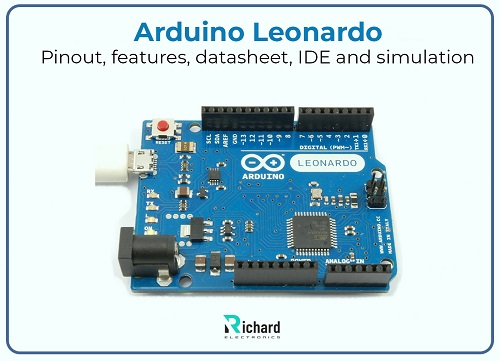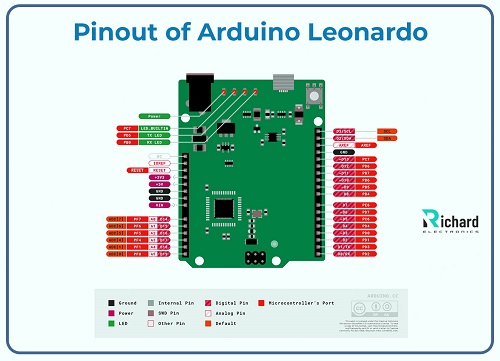Arduino Leonardo is a versatile and powerful microcontroller board, known for its ability to emulate a mouse or keyboard without requiring additional libraries. It features 20 digital I/O pins (7 of which support PWM output) and 12 analog input pins. Additionally, it supports UART, SPI, and I2C communication protocols. In this article, we'll explore its history, pinout, datasheet, features, IDE, and simulation.

### History of Arduino Leonardo (A000057):
- In 2012, Arduino Leonardo was released as part of the Arduino series, expanding the family of microcontroller boards.
- Based on the ATmega32u4 chip, it includes native USB support.
- It was the first Arduino board with native USB communication, excluding the need for an external USB-to-serial adapter.
- Designed for advanced projects that require direct interaction with a computer via a USB port.
- Fully supported by the Arduino IDE, making it easy to program.
- Features USB HID capabilities, setting it apart from previous Arduino boards.
- Widely used in professional prototyping and educational environments due to its versatility and unique features.
### Pinout of Arduino Leonardo:

#### Digital Pins:
The digital pins are divided into various categories based on their functions:
- **D0-D13**: These include serial communication pins (RX and TX), interrupt pins, and general-purpose I/O pins.
- **PWM Pins**: Pins 3, 5, 6, 9, 10, and 11 support pulse width modulation.
- A detailed table provides more information about each pin's function and purpose.
#### Power Pins:
- **GND**: Ground pins used to complete circuits.
- **5V**: Provides regulated power through USB or external power supply.
- **RESET**: Used to reset the microcontroller board.
- **VIN**: Input voltage pin for 7V–12V.
- **AREF**: Analog reference pin.
- **3.3V**: Regulated power supply pin.
#### Specific Pins:
- **Interrupt Pins**: Used for external interrupts.
- **Pin 13**: Connected to an onboard LED.
- **SPI**: Supports SPI communication via ICSP headers (MOSI, SCK, MISO).
- **I2C Pins**: Pins 2 and 3 are used for I2C communication (SDA and SCL).
#### Analog Input Pins:
- The 12 analog input pins (A0–A5) support 10-bit resolution and can be used for reading analog signals between 0V and 5V.
### Datasheet of Arduino Leonardo:
To understand the technical specifications of Arduino Leonardo, you can download the datasheet by clicking the link below:
[Download Arduino Leonardo Datasheet](#)
Here are some key specifications:
| Parameters | Technical Specifications |
|------------------------|------------------------------------|
| Microcontroller | ATmega32u4 |
| Flash Memory | 32 KB (4 KB used for bootloader) |
| Operating Voltage | 5V |
| Weight | 20 grams |
| SRAM | 2.5 KB |
| Length | 68.6 mm |
| Digital I/O Pins | 20 (general-purpose) |
| Width | 53.3 mm |
| Input Voltage | 7V–12V |
| PWM Pins | 7 (from 20 digital I/O pins) |
| EEPROM | 1 KB |
| Analog Input Pins | 12 |
| LED Pin | Pin 13 (built-in LED) |
### Conclusion:
Arduino Leonardo is a powerful and flexible microcontroller board ideal for a wide range of applications. Its native USB support, extensive I/O capabilities, and compatibility with the Arduino IDE make it a popular choice among hobbyists and professionals alike. Whether you're working on a simple project or a complex system, the Arduino Leonardo offers the performance and features needed to bring your ideas to life.
The carbide substrate is a tungsten carbide base designed for PDC (Polycrystalline Diamond Compact) tools, ensuring durability and performance in extreme conditions.
Key Features
- High Wear Resistance: Withstands abrasive environments for extended tool life.
- Excellent Toughness: Resists impact and heavy loads during drilling and cutting.
- Thermal Stability: Maintains integrity in high-temperature applications.
Applications
- Oil and Gas Drilling: Supports PDC cutters for deep well and shale gas exploration.
- Mining Tools: Enhances durability in rock cutting and mineral exploration.
- Geological Exploration: Improves performance in core drilling operations.
Substrate,PDC Substrate,Carbide Substrate for PDC,Tungsten Carbide PDC Substrate,PDC Cutter Substrate,Carbide Base for PDC Cutters,Cemented Carbide for PDC,PDC Base
Zigong MT Cemented Carbide Tech Co., Ltd. , https://www.mtcarbide.com